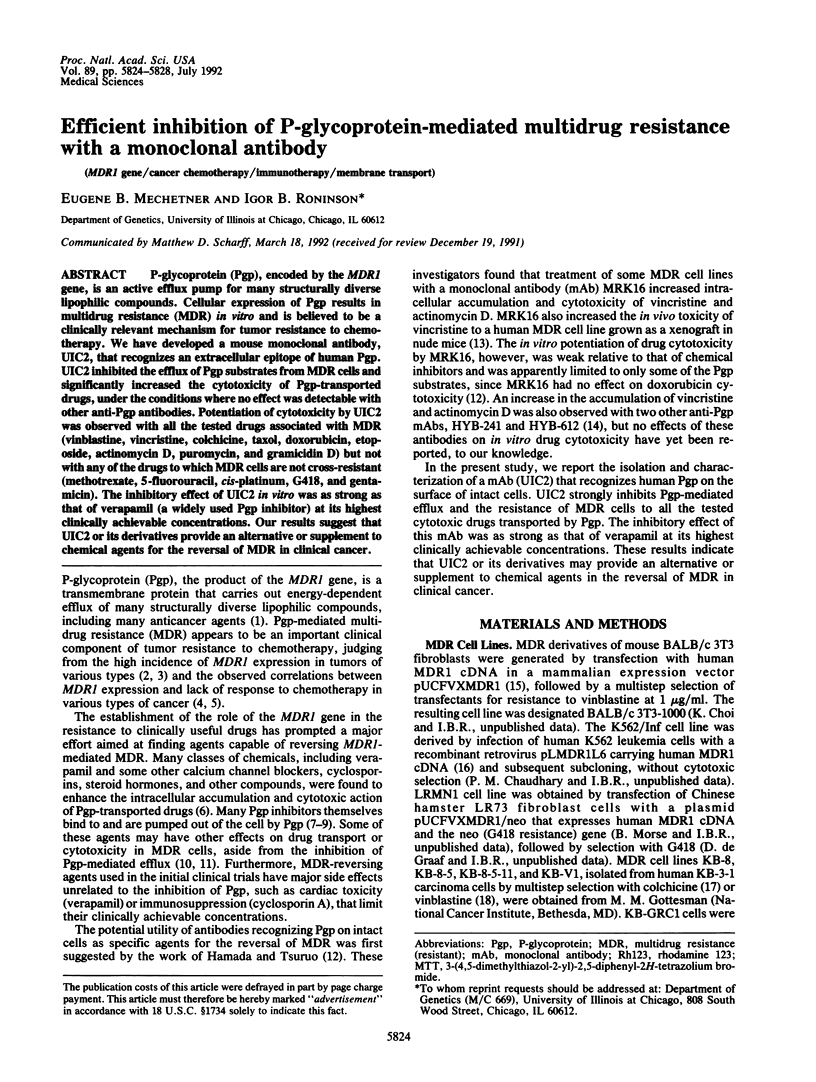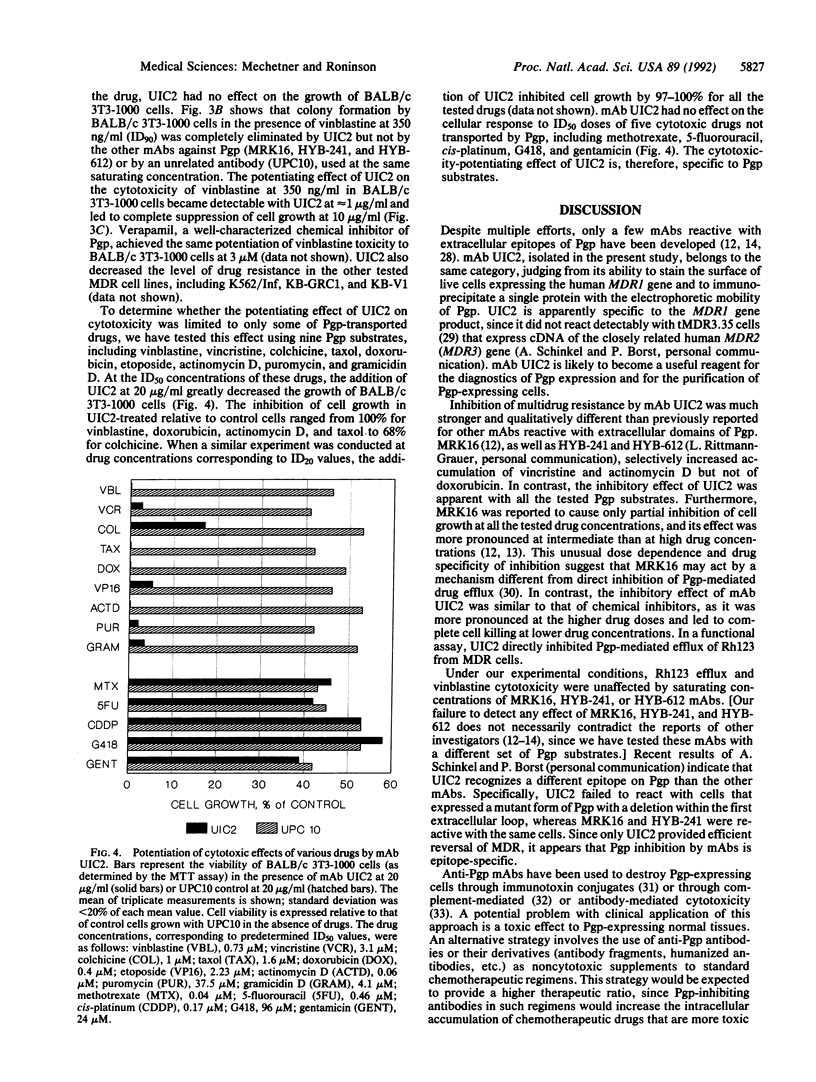Abstract
P-glycoprotein (Pgp), encoded by the MDR1 gene, is an active efflux pump for many structurally diverse lipophilic compounds. Cellular expression of Pgp results in multidrug resistance (MDR) in vitro and is believed to be a clinically relevant mechanism for tumor resistance to chemotherapy. We have developed a mouse monoclonal antibody, UIC2, that recognizes an extracellular epitope of human Pgp. UIC2 inhibited the efflux of Pgp substrates from MDR cells and significantly increased the cytotoxicity of Pgp-transported drugs, under the conditions where no effect was detectable with other anti-Pgp antibodies. Potentiation of cytotoxicity by UIC2 was observed with all the tested drugs associated with MDR (vinblastine, vincristine, colchicine, taxol, doxorubicin, etoposide, actinomycin D, puromycin, and gramicidin D) but not with any of the drugs to which MDR cells are not cross-resistant (methotrexate, 5-fluorouracil, cis-platinum, G418, and gentamicin). The inhibitory effect of UIC2 in vitro was as strong as that of verapamil (a widely used Pgp inhibitor) at its highest clinically achievable concentrations. Our results suggest that UIC2 or its derivatives provide an alternative or supplement to chemical agents for the reversal of MDR in clinical cancer.
Full text
PDF




Images in this article
Selected References
These references are in PubMed. This may not be the complete list of references from this article.
- Akiyama S., Fojo A., Hanover J. A., Pastan I., Gottesman M. M. Isolation and genetic characterization of human KB cell lines resistant to multiple drugs. Somat Cell Mol Genet. 1985 Mar;11(2):117–126. doi: 10.1007/BF01534700. [DOI] [PubMed] [Google Scholar]
- Beck W. T. Do anti-P-glycoprotein antibodies have a future in the circumvention of multidrug resistance? J Natl Cancer Inst. 1991 Oct 2;83(19):1364–1366. doi: 10.1093/jnci/83.19.1364. [DOI] [PubMed] [Google Scholar]
- Beck W. T., Mueller T. J., Tanzer L. R. Altered surface membrane glycoproteins in Vinca alkaloid-resistant human leukemic lymphoblasts. Cancer Res. 1979 Jun;39(6 Pt 1):2070–2076. [PubMed] [Google Scholar]
- Cano-Gauci D. F., Riordan J. R. Action of calcium antagonists on multidrug resistant cells. Specific cytotoxicity independent of increased cancer drug accumulation. Biochem Pharmacol. 1987 Jul 1;36(13):2115–2123. doi: 10.1016/0006-2952(87)90139-0. [DOI] [PubMed] [Google Scholar]
- Cenciarelli C., Currier S. J., Willingham M. C., Thiebaut F., Germann U. A., Rutherford A. V., Gottesman M. M., Barca S., Tombesi M., Morrone S. Characterization by somatic cell genetics of a monoclonal antibody to the MDR1 gene product (P-glycoprotein): determination of P-glycoprotein expression in multi-drug-resistant KB and CEM cell variants. Int J Cancer. 1991 Feb 20;47(4):533–543. doi: 10.1002/ijc.2910470411. [DOI] [PubMed] [Google Scholar]
- Chan H. S., Haddad G., Thorner P. S., DeBoer G., Lin Y. P., Ondrusek N., Yeger H., Ling V. P-glycoprotein expression as a predictor of the outcome of therapy for neuroblastoma. N Engl J Med. 1991 Dec 5;325(23):1608–1614. doi: 10.1056/NEJM199112053252304. [DOI] [PubMed] [Google Scholar]
- Chan H. S., Thorner P. S., Haddad G., Ling V. Immunohistochemical detection of P-glycoprotein: prognostic correlation in soft tissue sarcoma of childhood. J Clin Oncol. 1990 Apr;8(4):689–704. doi: 10.1200/JCO.1990.8.4.689. [DOI] [PubMed] [Google Scholar]
- Chaudhary P. M., Roninson I. B. Expression and activity of P-glycoprotein, a multidrug efflux pump, in human hematopoietic stem cells. Cell. 1991 Jul 12;66(1):85–94. doi: 10.1016/0092-8674(91)90141-k. [DOI] [PubMed] [Google Scholar]
- Choi K. H., Chen C. J., Kriegler M., Roninson I. B. An altered pattern of cross-resistance in multidrug-resistant human cells results from spontaneous mutations in the mdr1 (P-glycoprotein) gene. Cell. 1988 May 20;53(4):519–529. doi: 10.1016/0092-8674(88)90568-5. [DOI] [PubMed] [Google Scholar]
- Choi K., Frommel T. O., Stern R. K., Perez C. F., Kriegler M., Tsuruo T., Roninson I. B. Multidrug resistance after retroviral transfer of the human MDR1 gene correlates with P-glycoprotein density in the plasma membrane and is not affected by cytotoxic selection. Proc Natl Acad Sci U S A. 1991 Aug 15;88(16):7386–7390. doi: 10.1073/pnas.88.16.7386. [DOI] [PMC free article] [PubMed] [Google Scholar]
- Cornwell M. M., Gottesman M. M., Pastan I. H. Increased vinblastine binding to membrane vesicles from multidrug-resistant KB cells. J Biol Chem. 1986 Jun 15;261(17):7921–7928. [PubMed] [Google Scholar]
- FitzGerald D. J., Willingham M. C., Cardarelli C. O., Hamada H., Tsuruo T., Gottesman M. M., Pastan I. A monoclonal antibody-Pseudomonas toxin conjugate that specifically kills multidrug-resistant cells. Proc Natl Acad Sci U S A. 1987 Jun;84(12):4288–4292. doi: 10.1073/pnas.84.12.4288. [DOI] [PMC free article] [PubMed] [Google Scholar]
- Foon K. A. Biological response modifiers: the new immunotherapy. Cancer Res. 1989 Apr 1;49(7):1621–1639. [PubMed] [Google Scholar]
- Ford J. M., Hait W. N. Pharmacology of drugs that alter multidrug resistance in cancer. Pharmacol Rev. 1990 Sep;42(3):155–199. [PubMed] [Google Scholar]
- Goldstein L. J., Galski H., Fojo A., Willingham M., Lai S. L., Gazdar A., Pirker R., Green A., Crist W., Brodeur G. M. Expression of a multidrug resistance gene in human cancers. J Natl Cancer Inst. 1989 Jan 18;81(2):116–124. doi: 10.1093/jnci/81.2.116. [DOI] [PubMed] [Google Scholar]
- Hamada H., Tsuruo T. Functional role for the 170- to 180-kDa glycoprotein specific to drug-resistant tumor cells as revealed by monoclonal antibodies. Proc Natl Acad Sci U S A. 1986 Oct;83(20):7785–7789. doi: 10.1073/pnas.83.20.7785. [DOI] [PMC free article] [PubMed] [Google Scholar]
- Hamada H., Tsuruo T. Purification of the 170- to 180-kilodalton membrane glycoprotein associated with multidrug resistance. 170- to 180-kilodalton membrane glycoprotein is an ATPase. J Biol Chem. 1988 Jan 25;263(3):1454–1458. [PubMed] [Google Scholar]
- Heike Y., Hamada H., Inamura N., Sone S., Ogura T., Tsuruo T. Monoclonal anti-P-glycoprotein antibody-dependent killing of multidrug-resistant tumor cells by human mononuclear cells. Jpn J Cancer Res. 1990 Nov;81(11):1155–1161. doi: 10.1111/j.1349-7006.1990.tb02528.x. [DOI] [PMC free article] [PubMed] [Google Scholar]
- Horio M., Gottesman M. M., Pastan I. ATP-dependent transport of vinblastine in vesicles from human multidrug-resistant cells. Proc Natl Acad Sci U S A. 1988 May;85(10):3580–3584. doi: 10.1073/pnas.85.10.3580. [DOI] [PMC free article] [PubMed] [Google Scholar]
- Hsu S. I., Lothstein L., Horwitz S. B. Differential overexpression of three mdr gene family members in multidrug-resistant J774.2 mouse cells. Evidence that distinct P-glycoprotein precursors are encoded by unique mdr genes. J Biol Chem. 1989 Jul 15;264(20):12053–12062. [PubMed] [Google Scholar]
- Kartner N., Evernden-Porelle D., Bradley G., Ling V. Detection of P-glycoprotein in multidrug-resistant cell lines by monoclonal antibodies. 1985 Aug 29-Sep 4Nature. 316(6031):820–823. doi: 10.1038/316820a0. [DOI] [PubMed] [Google Scholar]
- Kearney J. F., Radbruch A., Liesegang B., Rajewsky K. A new mouse myeloma cell line that has lost immunoglobulin expression but permits the construction of antibody-secreting hybrid cell lines. J Immunol. 1979 Oct;123(4):1548–1550. [PubMed] [Google Scholar]
- Kohno K., Sato S., Uchiumi T., Takano H., Kato S., Kuwano M. Tissue-specific enhancer of the human multidrug-resistance (MDR1) gene. J Biol Chem. 1990 Nov 15;265(32):19690–19696. [PubMed] [Google Scholar]
- Meyers M. B., Rittmann-Grauer L., O'Brien J. P., Safa A. R. Characterization of monoclonal antibodies recognizing a Mr 180,000 P-glycoprotein: differential expression of the Mr 180,000 and Mr 170,000 P-glycoproteins in multidrug-resistant human tumor cells. Cancer Res. 1989 Jun 15;49(12):3209–3214. [PubMed] [Google Scholar]
- Miller T. P., Grogan T. M., Dalton W. S., Spier C. M., Scheper R. J., Salmon S. E. P-glycoprotein expression in malignant lymphoma and reversal of clinical drug resistance with chemotherapy plus high-dose verapamil. J Clin Oncol. 1991 Jan;9(1):17–24. doi: 10.1200/JCO.1991.9.1.17. [DOI] [PubMed] [Google Scholar]
- Neyfakh A. A. Use of fluorescent dyes as molecular probes for the study of multidrug resistance. Exp Cell Res. 1988 Jan;174(1):168–176. doi: 10.1016/0014-4827(88)90152-8. [DOI] [PubMed] [Google Scholar]
- Noonan K. E., Beck C., Holzmayer T. A., Chin J. E., Wunder J. S., Andrulis I. L., Gazdar A. F., Willman C. L., Griffith B., Von Hoff D. D. Quantitative analysis of MDR1 (multidrug resistance) gene expression in human tumors by polymerase chain reaction. Proc Natl Acad Sci U S A. 1990 Sep;87(18):7160–7164. doi: 10.1073/pnas.87.18.7160. [DOI] [PMC free article] [PubMed] [Google Scholar]
- Pauwels R., Balzarini J., Baba M., Snoeck R., Schols D., Herdewijn P., Desmyter J., De Clercq E. Rapid and automated tetrazolium-based colorimetric assay for the detection of anti-HIV compounds. J Virol Methods. 1988 Aug;20(4):309–321. doi: 10.1016/0166-0934(88)90134-6. [DOI] [PubMed] [Google Scholar]
- Pearson J. W., Fogler W. E., Volker K., Usui N., Goldenberg S. K., Gruys E., Riggs C. W., Komschlies K., Wiltrout R. H., Tsuruo T. Reversal of drug resistance in a human colon cancer xenograft expressing MDR1 complementary DNA by in vivo administration of MRK-16 monoclonal antibody. J Natl Cancer Inst. 1991 Oct 2;83(19):1386–1391. doi: 10.1093/jnci/83.19.1386. [DOI] [PubMed] [Google Scholar]
- Schinkel A. H., Roelofs E. M., Borst P. Characterization of the human MDR3 P-glycoprotein and its recognition by P-glycoprotein-specific monoclonal antibodies. Cancer Res. 1991 May 15;51(10):2628–2635. [PubMed] [Google Scholar]
- Shen D. W., Cardarelli C., Hwang J., Cornwell M., Richert N., Ishii S., Pastan I., Gottesman M. M. Multiple drug-resistant human KB carcinoma cells independently selected for high-level resistance to colchicine, adriamycin, or vinblastine show changes in expression of specific proteins. J Biol Chem. 1986 Jun 15;261(17):7762–7770. [PubMed] [Google Scholar]
- Sirotnak F. M., Yang C. H., Mines L. S., Oribé E., Biedler J. L. Markedly altered membrane transport and intracellular binding of vincristine in multidrug-resistant Chinese hamster cells selected for resistance to vinca alkaloids. J Cell Physiol. 1986 Feb;126(2):266–274. doi: 10.1002/jcp.1041260217. [DOI] [PubMed] [Google Scholar]
- Tamai I., Safa A. R. Competitive interaction of cyclosporins with the Vinca alkaloid-binding site of P-glycoprotein in multidrug-resistant cells. J Biol Chem. 1990 Sep 25;265(27):16509–16513. [PubMed] [Google Scholar]
- Tsuruo T., Hamada H., Sato S., Heike Y. Inhibition of multidrug-resistant human tumor growth in athymic mice by anti-P-glycoprotein monoclonal antibodies. Jpn J Cancer Res. 1989 Jul;80(7):627–631. doi: 10.1111/j.1349-7006.1989.tb01688.x. [DOI] [PMC free article] [PubMed] [Google Scholar]




